Empirical Analysis of Autonomous Vehicle’s LiDAR Detection Performance Degradation for Actual Road Driving in Rain and Fog
Abstract
:1. Introduction
1.1. Challenges of Autonomous Vehicles
1.2. LiDAR Sensors in AVs and Limitations
1.3. Research Approach
2. Literature Review
3. Methods
3.1. Test Site
3.2. Test Equipment and Objects
3.3. Test Scenario
3.4. Test Performance Indicators and Performance Verification Method
4. Point Cloud Plots
4.1. Overview
4.2. Point Cloud Plots According to Precipitation and Visibility Distance
4.2.1. Retroreflective Film (RF)
4.2.2. Aluminum (AL)
4.2.3. Steel (ST)
4.2.4. Plastic (PL)
4.2.5. Black Sheet (BS)
5. Changes in Performance Indicators
5.1. Overview
5.2. Performance Indicators According to Precipitation and Visibility Distance
6. Statistical Analysis of Performance Indicators
6.1. NPC Differences with Different Precipitations and Equal Distance
6.2. Post Hoc Analysis of NPC and Intensity
7. Discussion and Conclusions
Author Contributions
Funding
Institutional Review Board Statement
Informed Consent Statement
Data Availability Statement
Conflicts of Interest
Appendix A
| Key Term | Definition | |
|---|---|---|
| 1 | LiDAR performance | The ability to just detect an object. It is not an ability of recognition and classification. |
| 2 | PG | Road Weather Proving Ground in Korea |
| 3 | object | The object used in test was a 60 cm by 60 cm square-shaped road sign. |
| 4 | detection distance | Distance between the object and LiDAR |
| 5 | RF | Road sign made of retroreflective film |
| 6 | AL | Road sign made of aluminum |
| 7 | ST | Road sign made of steel |
| 8 | BS | Road sign made of black sheet |
| 9 | PL | Road sign made of plastic |
| 10 | light rain | precipitation 10–20 mm/h or less |
| 11 | intense rain | precipitation 30 mm/h or more |
| 12 | weak fog | Visibility distance 150 m or more |
| 13 | thick fog | visibility distance 50 m or less |
| 14 | plots of point clouds | Illustration of point groups reflected from the road sign |
| 15 | NPC | Performance indicator in the test, Number of Point Clouds |
| 16 | Intensity | Performance indicator in the test, the return strength of each laser pulse emitted from the LiDAR |
| 17 | ANOVA | A statistical method to identify difference between groups |
| 18 | Post hoc | A statistical method to identify difference between groups |
| 19 | LiDAR characteristic | Feasibility of LiDAR obtained in this study via empirical tests |
References
- Korea Institute of Civil Engineering and Building Technology. Improved Road Infrastructures to Strengthen Driving Safety of Automated Driving Car Final Report; KICT: Goyang-si, Republic of Korea, 2021. [Google Scholar]
- Yan, L.; Li, Z.; Liu, H.; Tan, J.; Zhao, S.; Chen, C. Detection and classification of pole-like road objects from mobile LiDAR data in motorway environment. Opt. Laser Technol. 2017, 97, 272–283. [Google Scholar] [CrossRef]
- Artificial Intelligence Times. [Contributed] Autonomous Driving Technology: (1) Changing the Landscape of the Automotive Industry. Available online: https://www.aitimes.kr/news/articleView.html?idxno=18941 (accessed on 10 September 2022).
- Roh, C.G.; Im, I. A review on handicap sections and situations to improve driving safety of automated vehicles. Sustainability 2020, 12, 5509. [Google Scholar] [CrossRef]
- Lv, C.; Cao, D.; Zhao, Y.; Auger, D.J.; Sullman, M.; Wang, H.; Dutka, L.M.; Skrypchuk, L.; Mouzakitis, A. Analysis of autopilot disengagements occurring during autonomous vehicle testing. IEEE/CAA J. Autom. Sin. 2018, 5, 58–68. [Google Scholar] [CrossRef] [Green Version]
- Lee, H.R.; Jung, H.Y. A study on the factor of individual preference for share-based fully autonomous vehicle. J. Korean Soc. Transp. 2020, 36, 429–439. [Google Scholar] [CrossRef]
- Herrmann, A.; Brenner, W.; Stadler, R. Autonomous Driving: How the Driverless Revolution Will Change the World (Korean Translated Version); Hanbit Biz Inc.: Seoul, Republic of Korea, 2019. [Google Scholar]
- Kim, W.K. Main contents and future plans of the automated driving technology development innovation project. Mon. KOTI Mag. Transp. 2020, 272, 27–35. [Google Scholar]
- Kim, J.; Park, B. A research of factors affecting LiDAR’s detection on road signs: Focus on shape and height of road sign. J. Korea Inst. Intell. Transp. Syst. 2022, 21. [Google Scholar] [CrossRef]
- Li, Y.; Ibanez-Guzman, J. LiDAR for autonomous driving: The principles, challenges, and trends for automotive lidar and perception systems. IEEE Signal. Process. Mag. 2020, 37, 50–61. [Google Scholar] [CrossRef]
- GSA. Autonomous Driving and Sensor Fusion SoCs. Available online: https://www.gsaglobal.org/forums/autonomous-driving-and-sensor-fusion-socs/ (accessed on 5 October 2022).
- Tang, L.; Shi, Y.; He, Q.; Sadek, A.W.; Qiao, C. Performance test of autonomous vehicle LiDAR sensors under different weather conditions. Transp. Res. Rec. 2020, 2674, 319–329. [Google Scholar] [CrossRef]
- Park, B. Method of improvements for autonomous vehicle road-traffic facilities using LiDAR. In Proceedings of the KITS International Conference 2022, Seogwuipo, Republic of Korea, 15–18 June 2022. [Google Scholar]
- Velodyne Lidar. Available online: https://velodynelidar.com/products/ (accessed on 11 September 2022).
- Chen, C.; Fragonara, L.Z.; Tsourdos, A. RoIFusion: 3D object detection from LiDAR and vision. IEEE Access 2021, 9, 51710–51721. [Google Scholar] [CrossRef]
- Dannheim, C.; Icking, C.; Mäder, M.; Sallis, P. Weather detection in vehicles by means of camera and LiDAR systems. In Proceedings of the Sixth International Conference on Computational Intelligence, Communication Systems and Networks 2014, Tetova, Macedonia, 27–29 May 2014. [Google Scholar] [CrossRef]
- Yeoung, D.J.; Velasco-Hernandez, G.; Barry, J.; Walsh, J. Sensor and sensor fusion technology in autonomous vehicles: A review. Sensors 2021, 21, 2140. [Google Scholar] [CrossRef]
- Park, B.; Kim, J. A study of LiDAR’s performance change by road sign’s color and climate. J. Korea Inst. Intell. Transp. Syst. 2019, 20, 228–241. [Google Scholar] [CrossRef]
- Kutila, M.; Pyykönen, P.; Ritter, W.; Sawade, O.; Schäufele, B. Automotive LIDAR sensor development scenarios for harsh weather conditions. In Proceedings of the 2016 IEEE 19th International Conference on Intelligent Transportation Systems (ITSC), Rio de Janeiro, Brazil, 1–4 November 2016; IEEE: New York, NY, USA, 2016; pp. 265–270. [Google Scholar]
- Montalban, K.; Reymann, C.; Atchuthan, D.; Dupouy, P.E.; Riviere, N.; Lacroix, S. A quantitative analysis of point clouds from automotive LiDARs exposed to artificial rain and fog. Atmosphere 2021, 12, 738. [Google Scholar] [CrossRef]
- Kim, J.; Park, B. A study of LiDAR’s detection performance degradation in fog and rain climate. J. Korea Inst. Intell. Transp. Syst. 2021, 21, 101–115. [Google Scholar] [CrossRef]
- Kim, J.; Park, B.; Roh, C.G.; Kim, Y. Performance of mobile LiDAR in the real road driving conditions. Sensors 2021, 21, 7461. [Google Scholar] [CrossRef] [PubMed]
- Goodin, C.; Carruth, D.; Doude, M.; Hudson, C. Predicting the influence of rain on LiDAR in ADAS. Electronics 2019, 8, 89. [Google Scholar] [CrossRef] [Green Version]
- Beraldin, J.; Blais, F. Laser scanning technology. In Airborne and Terrestrial Laser Scanning; Vosselman, G., Mass, H., Eds.; Whittles Publishing: Caithness, UK, 2010; pp. 1–42. [Google Scholar]
- Elhashash, M.; Albanwan, H.; Qin, R. A review of mobile mapping systems: From sensors to applications. Sensors 2022, 22, 4262. [Google Scholar] [CrossRef]
- Lee, I.S.; Lee, J.O. Performance evaluation of terrestrial laser scanner over calibration baseline. J. Korea Soc. Survey. Geodesy. Photogramm. Cartograph. 2010, 28, 329–336. [Google Scholar]
- Jeon, H.; Kim, J. Analysis on handicaps of automated vehicle and their causes using IPA and FGI. J. Korea Inst. Intell. Transp. Syst. 2021, 20, 34–46. [Google Scholar] [CrossRef]
- Yan, X.; Zheng, C.; Li, Z.; Cui, S.; Dai, D. Benchmarking the Robustness of LiDAR Semantic Segmentation Models. arXiv 2023, arXiv:2301.00970. [Google Scholar]
- Peng, K.; Fei, J.; Yang, K.; Roitberg, A.; Zhang, J.; Bieder, F.; Heidenreich, P.; Stiller, C.; Stiefelhagen, R. MASS: Multi-Attentional Semantic Segmentation of LiDAR Data for Dense Top-View Understanding. IEEE Trans. Intell. Transp. Syst. 2022, 23, 15824–15840. [Google Scholar] [CrossRef]
- Kim, J.; Kim, J. Empirical research on improving traffic cone considering LiDAR’s characteristics. J. Korea Inst. Intell. Transp. Syst. 2022, 21, 253–273. [Google Scholar] [CrossRef]
- Buyval, A.; Gabdullin, A.; Lyubimov, M. Road Sign Detection and Localization Based on Camera and Lidar Data. In Proceedings of the Eleventh International Conference on Machine Vision (ICMV 2018), Munich, Germany, 1–3 November 2018. [Google Scholar]
- Ghallabi, F.; Nashashibi, F.; El-Haj-Shhade, G.; Mittet, M.-A. LIDAR-Based Lane Marking Detection For Vehicle Positioning in an HD Map. In Proceedings of the 2018 21st International Conference on Intelligent Transportation Systems (ITSC), Maui, HI, USA, 4–7 November 2018. [Google Scholar]
- Guan, H.; Li, J.; Cao, S.; Yu, Y. Use of mobile LiDAR in road information inventory: A review. Int. J. Image Data Fusion 2016, 7, 219–242. [Google Scholar] [CrossRef]
- Bloomberg Businessweek, Self-Driving Cars Can Handle Neither Rain NOR Sleet Nor Snow. Available online: https://www.bloomberg.com/news/articles/2018-09-17/self-driving-cars-still-can-t-handle-bad-weather (accessed on 23 June 2021).
- Schulte-Tigges, J.; Förster, M.; Nikolovski, G.; Reke, M.; Ferrein, A.; Kaszner, D.; Matheis, D.; Walter, T. Benchmarking of Various LiDAR Sensors for Use in Self-Driving Vehicles in Real-World Environments. Sensors 2022, 22, 7146. [Google Scholar] [CrossRef]
- Kashani, O.; Parrish, W. A review of LIDAR radiometric processing: From ad hoc intensity correction to rigorous radiometric calibration. Sensors 2015, 15, 28099. [Google Scholar] [CrossRef] [PubMed] [Green Version]
- Robosense. [Contributed] Point Cloud Defects That 99% of LiDAR Suppliers Won’t Let You Know. Available online: https://www.robosense.ai/en/tech-show-55 (accessed on 10 January 2023).
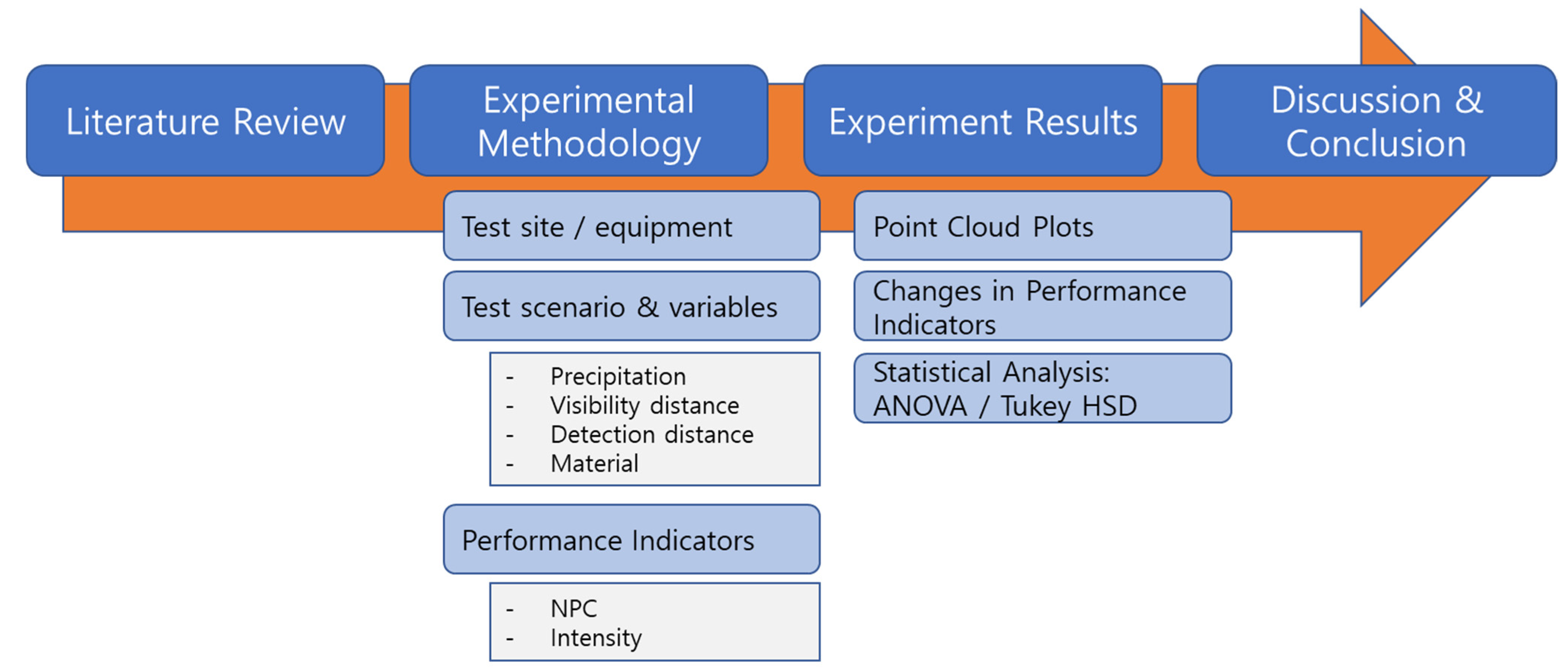



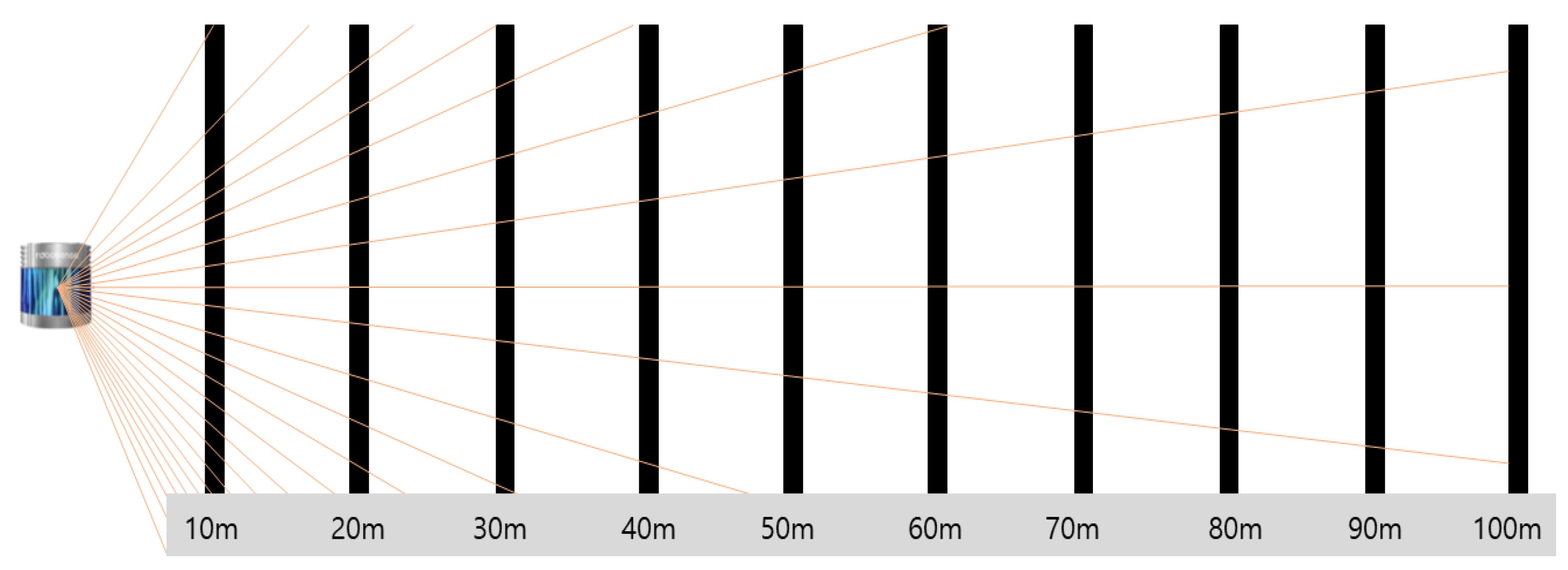
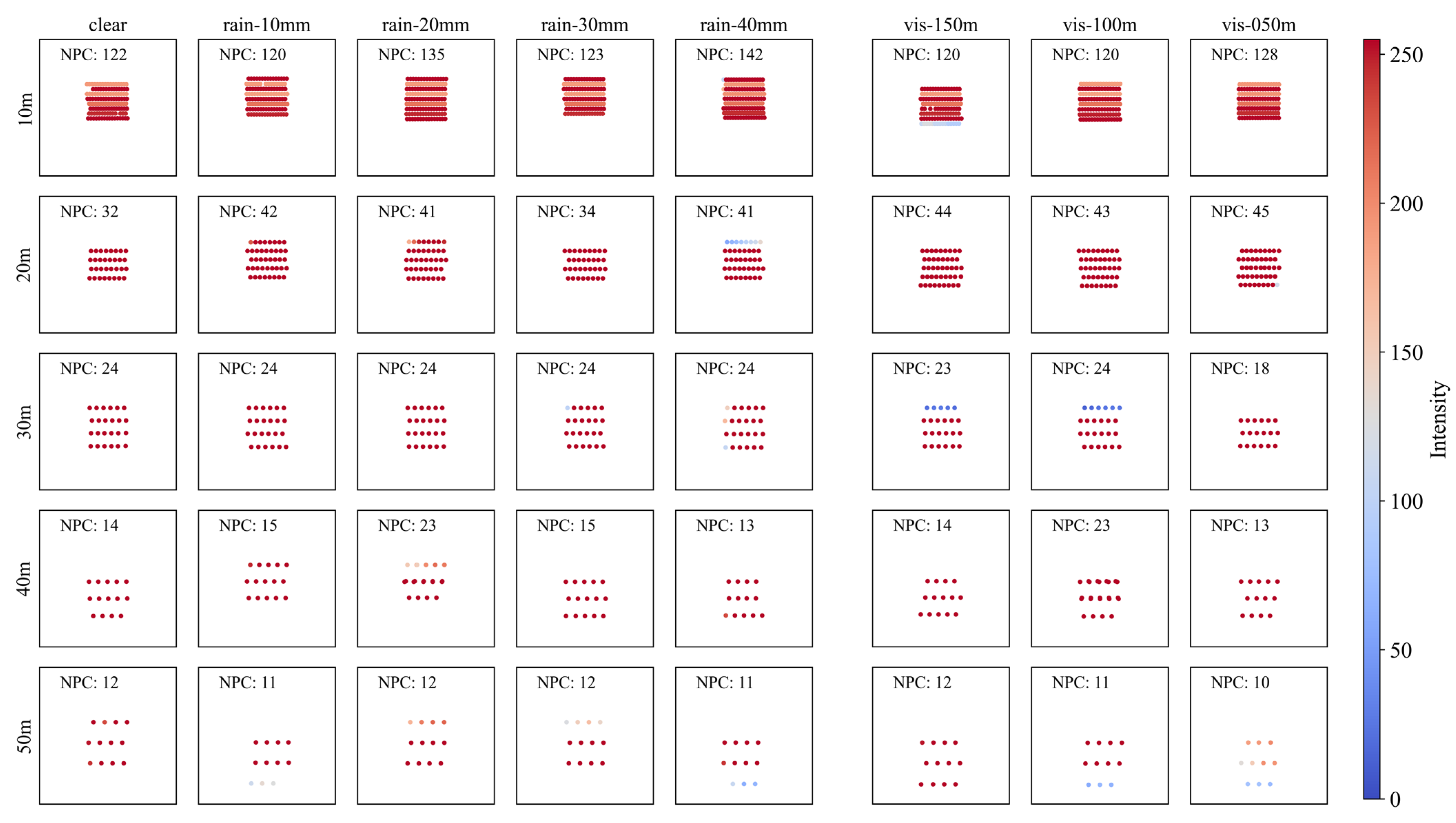
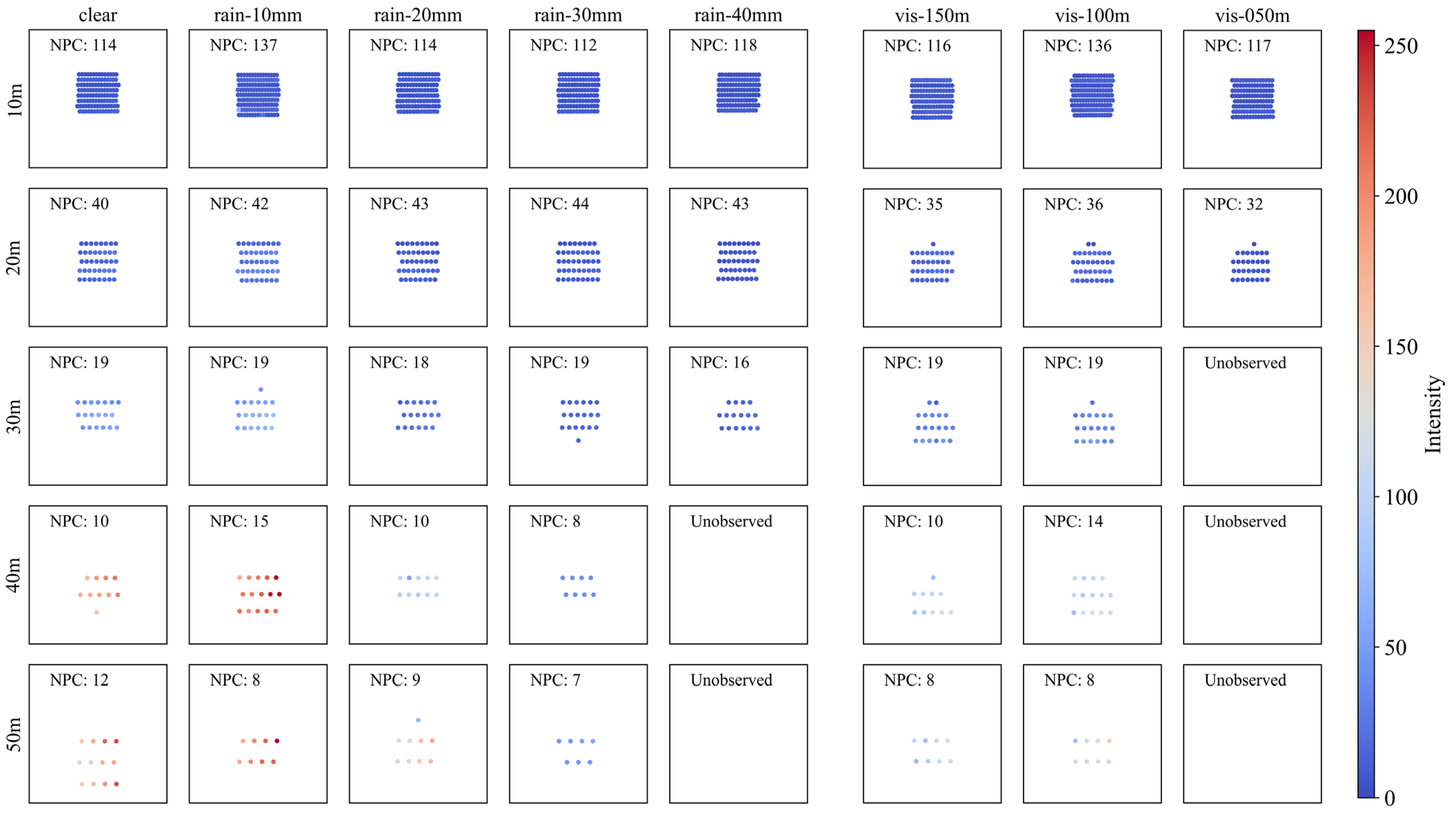
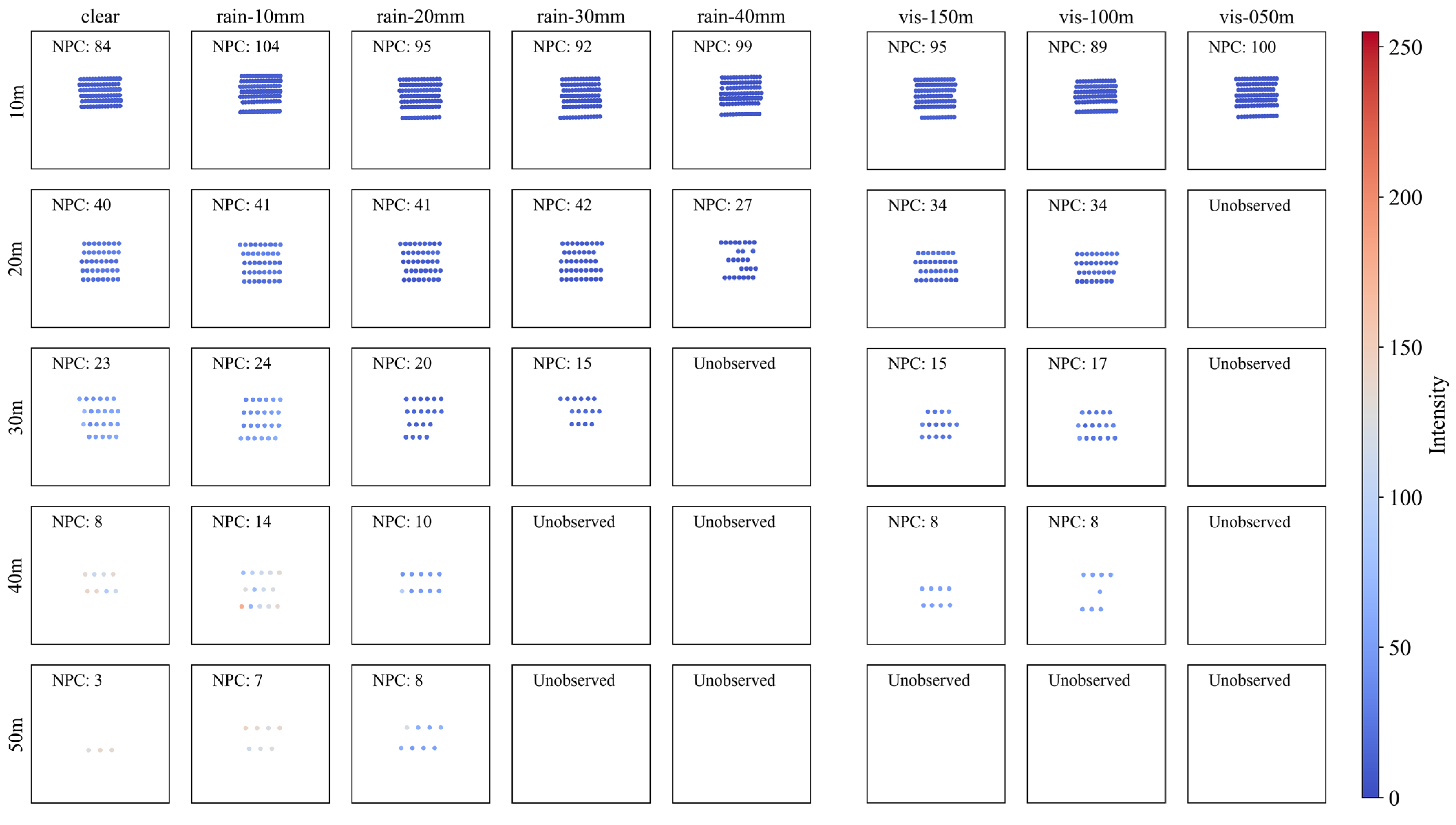
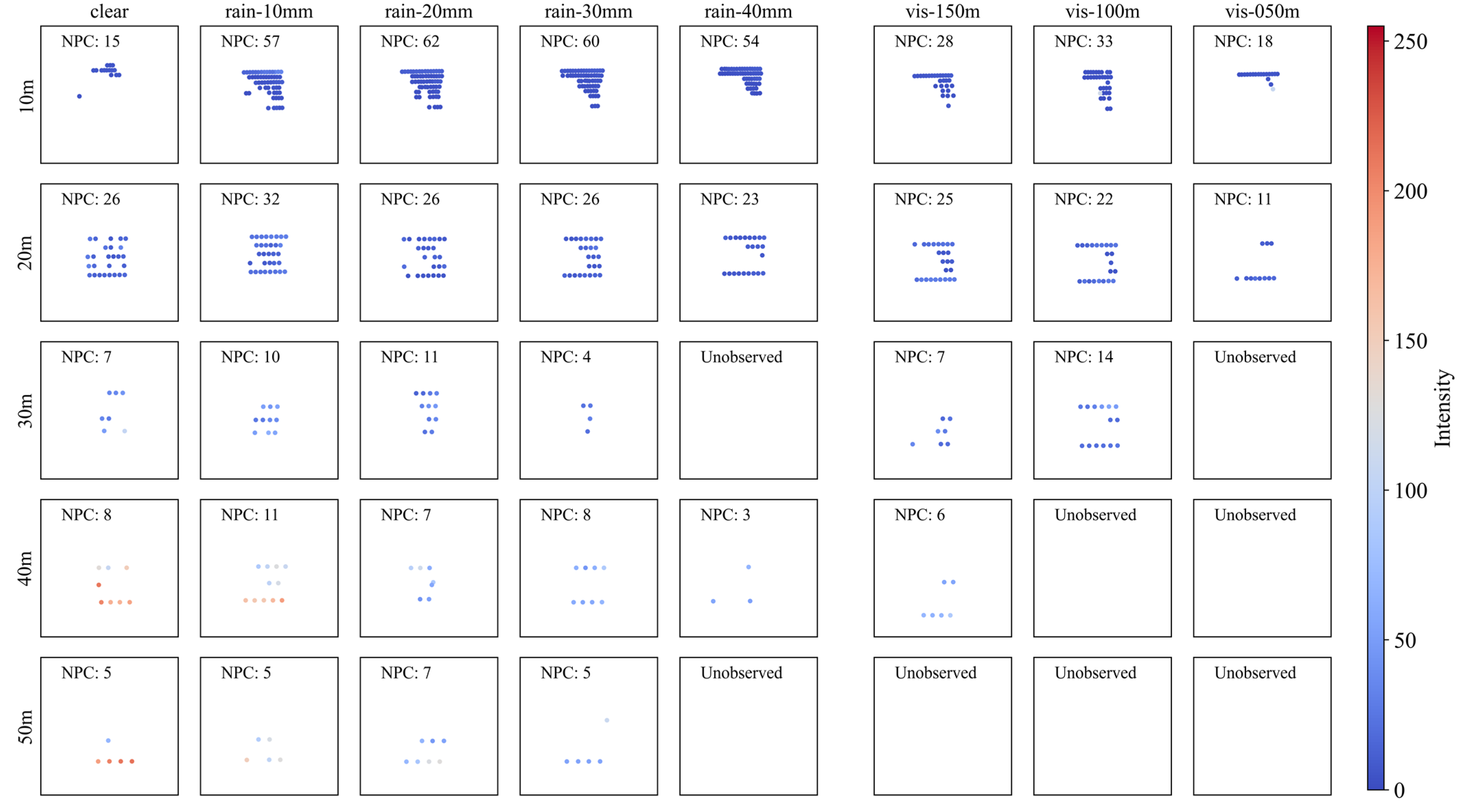


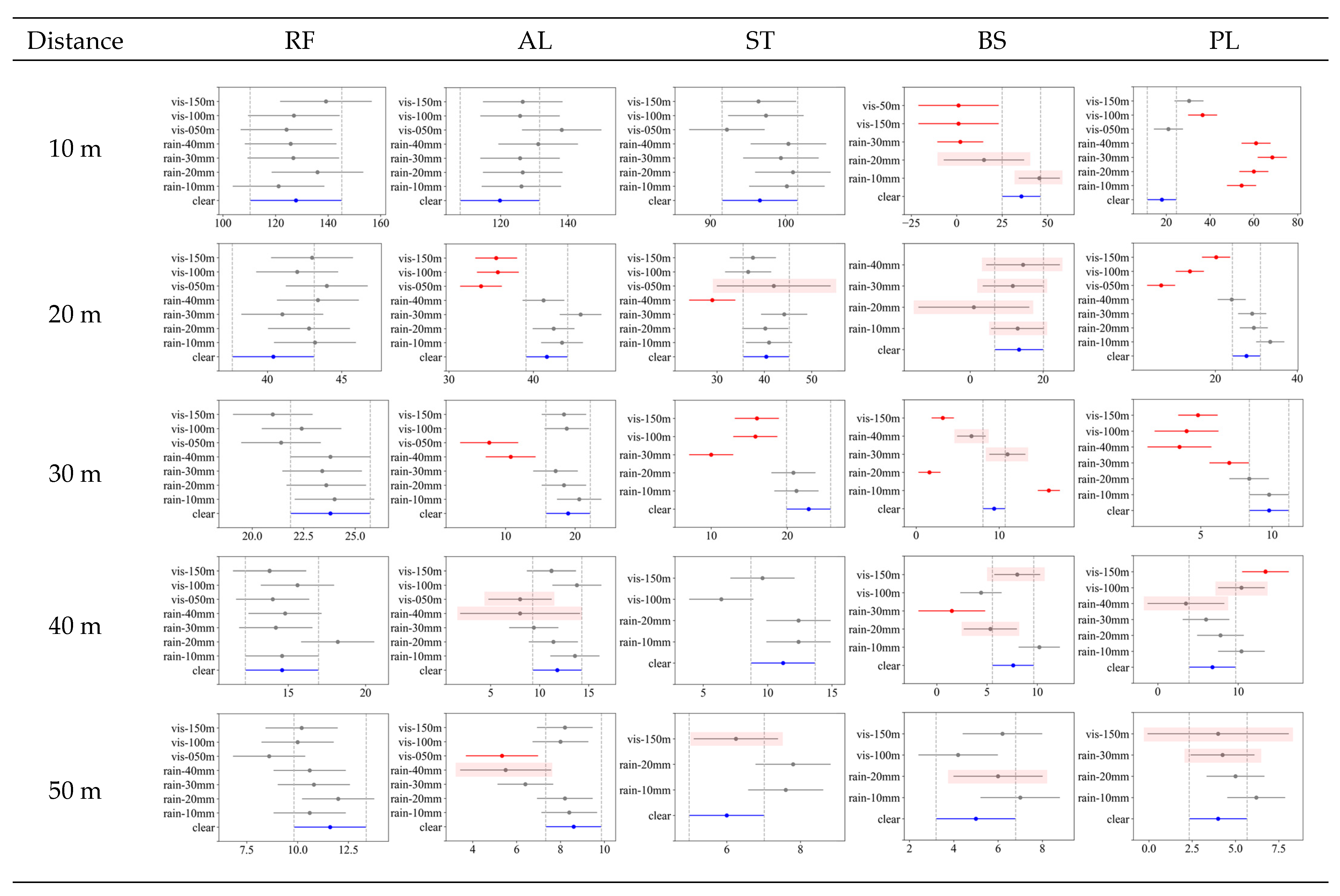
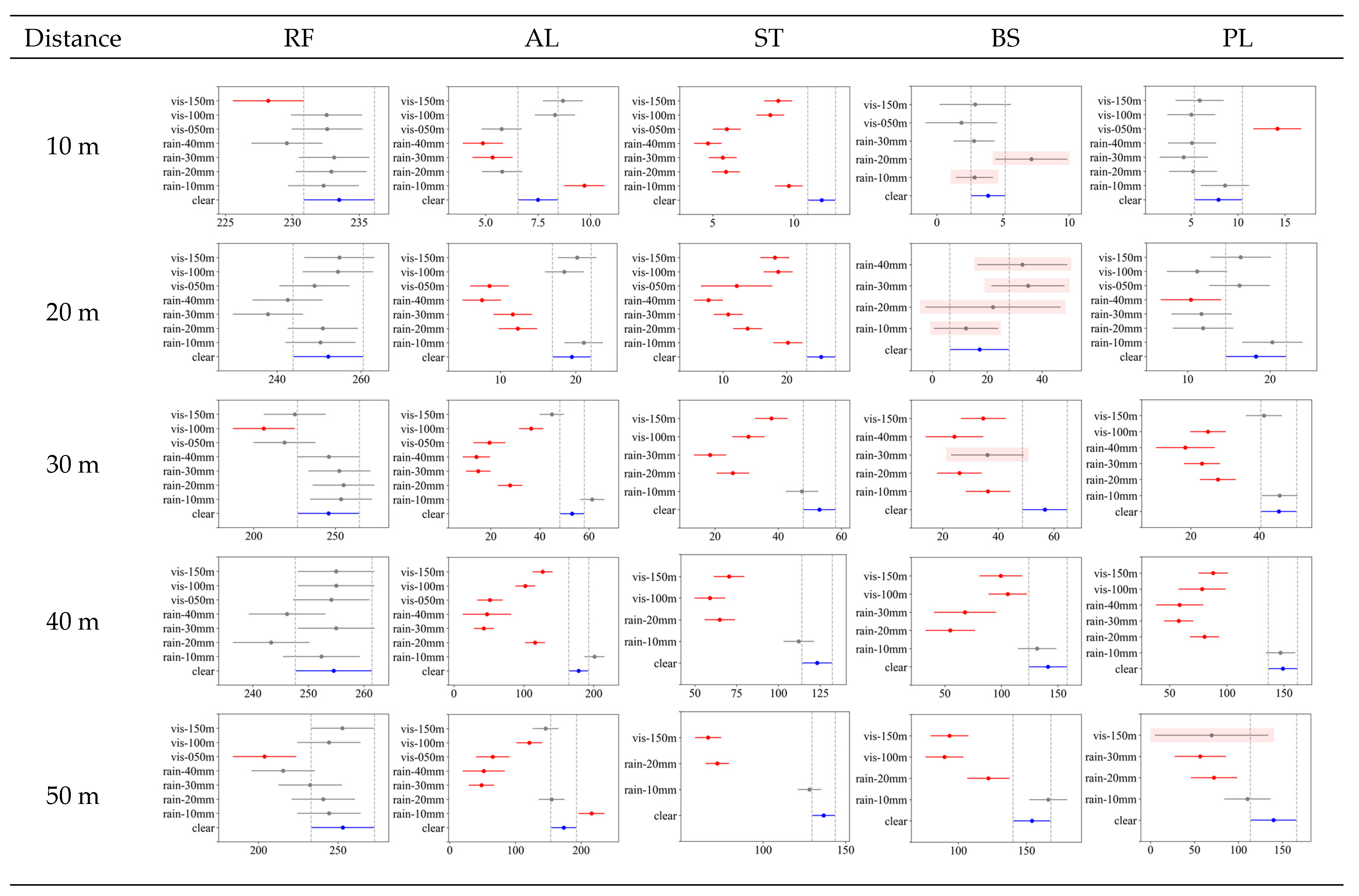

| Studies | Data Analysis Environment | Weather Conditions | Findings | Limitations |
|---|---|---|---|---|
| Kutila et al. [19] | Real road | Fog/Snow | Detection performance (detection distance) of LiDAR was reduced by 25% in fog and snowfall conditions | The amount of snowfall or fog visibility was not accurate |
| Goodin et al. [23] | Simulation | Rain | At the maximum rainfall of 45 mm/h, the maximum recognition distance decreased by approximately 30% (5 m) compared to a clear day, and the NPC decreased by 45%. | Results of simulations do not reflect some variables in real situations |
| Tang et al. [12] | Real road (parking lot) | Rain | Estimating probability of pedestrian detection significantly decreased on rainy days | The relationship between the actual amount of rainfall and the detection performance of LiDAR could not be proven |
| Kim et al. [22] | Real road | Rain | Distance and rainfall affect NPC and intensity Materials affect intensity. Speed does not affect the detection performance of LiDAR. | Correlation between all factors could not be confirmed |
| Performance | Robosense RS-32 | Velodyne Ultra Puck | Hesai XT-32 | Ouster OS1-32 | Velodyne Velarray H800 |
|---|---|---|---|---|---|
| Principle | Rotation | Rotation | Rotation | Rotation | Solid State |
| No. of channel | 32 | 32 | 32 | 32 | - |
| Laser wavelength | 905 nm | 903 nm | 905 nm | 865 nm | 905 nm |
| Measurement Range | 200 m | 200 m | 120 m | 120 m | 200 m |
| Horizontal angular resolution | 0.1°–0.4° (5–20 Hz) | 0.1°–0.4° (5–20 Hz) | 0.18° (10 Hz) | 0.18°–0.7° (10 or 20 Hz) | 0.26° |
| Vertical angular Resolution | 0.33° (minimum) | 0.33°(minimum) | 1° | 0.35°–2.8° | 0.2°–0.5° |
| Vertical FOV | 40° (−25° to +15°) | 40° (−25° to +15°) | 31° (−16° to 15°) | 45° (−22.5° to 22.5°) | 16°(Vertical) 120°(Horizontal) |
| Points per second | 600,000 pts/s @single return | 600,000 pts/s @single return | 640,000 pts/s @single return | 655,360 pts/s @single return | 400,000 pts/s [35] @single return |
| Factors | Control Conditions |
|---|---|
| material | white retroreflective film, aluminum, steel, plastic, and black sheet |
| weather | Clear rain: 10, 20, 30, and 40 mm/h fog intensity (i.e., visibility distance): 50, 100, and 150 m |
| detection distance | 10, 20, 30, 40, and 50 m |
| number of drives | five for each test condition |
| Detection Distance | Weather | Materials | |||||||||||||||||||
|---|---|---|---|---|---|---|---|---|---|---|---|---|---|---|---|---|---|---|---|---|---|
| RF | AL | ST | PL | BS | |||||||||||||||||
| N | Mean | Std | Ratio | N | Mean | Std | Ratio | N | Mean | Std | Ratio | N | Mean | Std | Ratio | N | Mean | Std | Ratio | ||
| 10 m | clear | 5 | 127.8 | 11.4 | 5 | 119.8 | 10.2 | 5 | 96.6 | 7.5 | 5 | 18.0 | 2.9 | 5 | 35.6 | 7.7 | |||||
| rain10 | 5 | 121.2 | 9.3 | 0.95 | 5 | 126.2 | 16.9 | 1.05 | 5 | 100.2 | 3.2 | 1.04 | 5 | 54.4 | 5.2 | 3.02 | 4 | 45.5 | 11.9 | 1.28 | |
| rain20 | 5 | 136.0 | 31.1 | 1.06 | 5 | 126.6 | 9.7 | 1.06 | 5 | 101.0 | 3.8 | 1.05 | 5 | 60.0 | 2.5 | 3.33 | 1 | 15.0 | - | 0.42 | |
| rain30 | 5 | 126.8 | 8.5 | 0.99 | 5 | 125.8 | 13.0 | 1.05 | 5 | 99.4 | 4.4 | 1.03 | 5 | 68.4 | 11.5 | 3.80 | 3 | 2.0 | 1.7 | 0.06 | |
| rain40 | 5 | 125.8 | 11.9 | 0.98 | 5 | 131.2 | 7.5 | 1.10 | 5 | 100.4 | 2.1 | 1.04 | 5 | 61.0 | 9.7 | 3.39 | - | - | - | - | |
| vis150 | 5 | 139.2 | 27.7 | 1.09 | 5 | 126.6 | 8.2 | 1.06 | 5 | 96.4 | 6.3 | 1.00 | 5 | 30.4 | 6.9 | 1.69 | 1 | 1.0 | - | 0.03 | |
| vis100 | 5 | 127.0 | 11.9 | 0.99 | 5 | 125.8 | 9.4 | 1.05 | 5 | 97.4 | 5.1 | 1.01 | 5 | 36.6 | 2.3 | 2.03 | - | - | - | - | |
| vis50 | 5 | 124.2 | 4.0 | 0.97 | 5 | 138.2 | 14.2 | 1.15 | 5 | 92.2 | 4.9 | 0.95 | 5 | 21.0 | 3.7 | 1.17 | 1 | 1.0 | - | 0.03 | |
| 20 m | clear | 5 | 40.4 | 4.9 | 5 | 41.6 | 1.1 | 5 | 40.4 | 2.2 | 5 | 27.6 | 0.9 | 5 | 13.4 | 1.8 | |||||
| rain10 | 5 | 43.2 | 1.1 | 1.07 | 5 | 43.4 | 1.3 | 1.04 | 5 | 41.0 | 2.4 | 1.01 | 5 | 33.4 | 2.7 | 1.21 | 4 | 13.0 | 8.8 | 0.97 | |
| rain20 | 5 | 42.8 | 1.8 | 1.06 | 5 | 42.4 | 0.9 | 1.02 | 5 | 40.2 | 3.6 | 1.00 | 5 | 29.4 | 3.2 | 1.07 | 1 | 1.0 | - | 0.07 | |
| rain30 | 5 | 41.0 | 3.9 | 1.01 | 5 | 45.6 | 4.2 | 1.10 | 5 | 44.2 | 3.7 | 1.09 | 5 | 29.0 | 2.1 | 1.05 | 3 | 11.7 | 7.8 | 0.87 | |
| rain40 | 5 | 43.4 | 1.7 | 1.07 | 5 | 41.2 | 2.0 | 0.99 | 5 | 29.0 | 7.3 | 0.72 | 5 | 24.0 | 1.2 | 0.87 | 2 | 14.5 | 3.5 | 1.08 | |
| vis150 | 5 | 43.0 | 1.6 | 1.06 | 5 | 35.6 | 1.9 | 0.86 | 5 | 37.6 | 5.9 | 0.93 | 5 | 20.2 | 5.7 | 0.73 | - | - | - | - | |
| vis100 | 5 | 42.0 | 1.0 | 1.04 | 5 | 35.8 | 3.9 | 0.86 | 5 | 36.6 | 5.5 | 0.91 | 5 | 13.8 | 4.6 | 0.50 | - | - | - | - | |
| vis50 | 5 | 44.0 | 2.7 | 1.09 | 5 | 33.8 | 1.5 | 0.81 | 1 | 42.0 | - | 1.04 | 5 | 6.8 | 3.4 | 0.25 | - | - | - | - | |
| 30 m | clear | 5 | 23.8 | 0.4 | 5 | 19.0 | 1.2 | 5 | 22.8 | 0.8 | 5 | 6.8 | 1.5 | 5 | 9.4 | 1.5 | |||||
| rain10 | 5 | 24.0 | 0.0 | 1.01 | 5 | 20.6 | 2.1 | 1.08 | 5 | 21.2 | 3.7 | 0.93 | 5 | 10.4 | 1.7 | 1.53 | 5 | 16.0 | 1.7 | 1.70 | |
| rain20 | 5 | 23.6 | 0.9 | 0.99 | 5 | 18.4 | 0.5 | 0.97 | 5 | 20.8 | 0.8 | 0.91 | 5 | 7.8 | 1.9 | 1.15 | 5 | 1.6 | 0.5 | 0.17 | |
| rain30 | 5 | 23.4 | 0.5 | 0.98 | 5 | 17.2 | 1.3 | 0.91 | 5 | 10.0 | 5.8 | 0.44 | 5 | 6.0 | 1.6 | 0.88 | 2 | 11.0 | 0.0 | 1.17 | |
| rain40 | 5 | 23.8 | 0.4 | 1.00 | 4 | 10.8 | 6.0 | 0.57 | - | - | - | - | 2 | 3.5 | 2.1 | 0.51 | 3 | 6.7 | 0.6 | 0.71 | |
| vis150 | 5 | 21.0 | 2.7 | 0.88 | 5 | 18.4 | 0.5 | 0.97 | 5 | 16.0 | 1.9 | 0.70 | 5 | 13.4 | 3.6 | 1.97 | 5 | 3.2 | 1.6 | 0.34 | |
| vis100 | 5 | 22.4 | 3.6 | 0.94 | 5 | 18.8 | 1.3 | 0.99 | 5 | 15.8 | 0.8 | 0.69 | 5 | 10.4 | 5.1 | 1.53 | - | - | - | - | |
| vis50 | 5 | 21.4 | 2.6 | 0.90 | 3 | 7.7 | 8.1 | 0.41 | - | - | - | - | - | - | - | - | - | - | - | - | |
| 40 m | clear | 5 | 14.6 | 0.5 | 5 | 11.8 | 2.0 | 5 | 11.2 | 2.8 | 5 | 9.8 | 1.5 | 5 | 7.6 | 2.1 | |||||
| rain10 | 5 | 14.6 | 0.5 | 1.00 | 5 | 13.6 | 1.9 | 1.15 | 5 | 12.4 | 1.3 | 1.11 | 5 | 9.8 | 1.3 | 1.00 | 5 | 10.2 | 1.9 | 1.34 | |
| rain20 | 5 | 18.2 | 4.4 | 1.25 | 5 | 11.4 | 1.7 | 0.97 | 5 | 12.4 | 3.9 | 1.11 | 5 | 8.4 | 1.3 | 0.86 | 3 | 5.3 | 3.2 | 0.70 | |
| rain30 | 5 | 14.2 | 0.8 | 0.97 | 5 | 9.4 | 1.7 | 0.80 | - | - | - | - | 5 | 7.0 | 1.6 | 0.71 | 2 | 1.5 | 0.7 | 0.20 | |
| rain40 | 5 | 14.8 | 1.9 | 1.01 | 1 | 8.0 | - | 0.68 | - | - | - | - | 2 | 3.5 | 0.7 | 0.36 | - | - | - | - | |
| vis150 | 5 | 13.8 | 0.4 | 0.95 | 5 | 11.2 | 2.7 | 0.95 | 5 | 9.6 | 1.3 | 0.86 | 5 | 4.8 | 1.3 | 0.49 | 4 | 8.0 | 1.4 | 1.05 | |
| vis100 | 5 | 15.6 | 4.2 | 1.07 | 5 | 13.8 | 1.6 | 1.17 | 5 | 6.4 | 2.9 | 0.57 | 2 | 4.0 | 0.0 | 0.41 | 5 | 4.4 | 1.9 | 0.58 | |
| vis50 | 5 | 14.0 | 0.7 | 0.96 | 3 | 8.0 | 5.3 | 0.68 | - | - | - | - | - | - | - | - | - | - | - | - | |
| 50 m | clear | 5 | 11.6 | 0.9 | 5 | 8.6 | 2.1 | 5 | 6.0 | 2.0 | 5 | 4.0 | 1.9 | 5 | 5.0 | 1.2 | |||||
| rain10 | 5 | 10.6 | 1.5 | 0.91 | 5 | 8.4 | 0.9 | 0.98 | 5 | 7.6 | 0.5 | 1.27 | 5 | 6.2 | 0.8 | 1.55 | 5 | 7.0 | 0.7 | 1.40 | |
| rain20 | 5 | 12.0 | 0.7 | 1.03 | 5 | 8.2 | 0.4 | 0.95 | 5 | 7.8 | 0.4 | 1.30 | 5 | 5.0 | 2.5 | 1.25 | 4 | 6.0 | 2.7 | 1.20 | |
| rain30 | 5 | 10.8 | 2.2 | 0.93 | 5 | 6.4 | 1.9 | 0.74 | - | - | - | - | 4 | 4.2 | 0.5 | 1.05 | - | - | - | - | |
| rain40 | 5 | 10.6 | 1.5 | 0.91 | 2 | 5.5 | 0.7 | 0.64 | - | - | - | - | - | - | - | - | - | - | - | - | |
| vis150 | 5 | 10.2 | 2.5 | 0.88 | 5 | 8.2 | 0.4 | 0.95 | 4 | 6.2 | 0.5 | 1.03 | 1 | 4.0 | - | 1.00 | 5 | 6.2 | 2.9 | 1.24 | |
| vis100 | 5 | 10.0 | 2.3 | 0.86 | 5 | 8.0 | 0.0 | 0.93 | - | - | - | - | - | - | - | - | 5 | 4.2 | 0.8 | 0.84 | |
| vis50 | 5 | 8.6 | 1.3 | 0.74 | 3 | 5.3 | 1.2 | 0.62 | - | - | - | - | - | - | - | - | - | - | - | - | |
| Detection Distance | Weather | Materials | |||||||||||||||||||
|---|---|---|---|---|---|---|---|---|---|---|---|---|---|---|---|---|---|---|---|---|---|
| RF | AL | ST | PL | BS | |||||||||||||||||
| N | Mean | Std | Ratio | N | Mean | Std | Ratio | N | Mean | Std | Ratio | N | Mean | Std | Ratio | N | Mean | Std | Ratio | ||
| 10 m | clear | 5 | 233.5 | 2.6 | 5 | 7.5 | 0.3 | 5 | 11.7 | 0.3 | 5 | 7.9 | 2.9 | 5 | 3.9 | 0.8 | |||||
| rain10 | 5 | 232.3 | 1.4 | 0.99 | 5 | 9.7 | 2.3 | 1.29 | 5 | 9.7 | 2.1 | 0.83 | 5 | 8.6 | 1.8 | 1.09 | 4 | 2.9 | 1.5 | 0.74 | |
| rain20 | 5 | 232.9 | 2.0 | 1.00 | 5 | 5.8 | 0.8 | 0.77 | 5 | 5.8 | 0.4 | 0.50 | 5 | 5.2 | 0.8 | 0.66 | 1 | 7.2 | - | 1.85 | |
| rain30 | 5 | 233.1 | 1.4 | 1.00 | 5 | 5.3 | 0.2 | 0.71 | 5 | 5.6 | 0.3 | 0.48 | 5 | 4.2 | 0.5 | 0.53 | 3 | 2.8 | 0.7 | 0.72 | |
| rain40 | 5 | 229.6 | 4.3 | 0.98 | 5 | 4.9 | 0.4 | 0.65 | 5 | 4.7 | 0.6 | 0.40 | 5 | 5.1 | 0.4 | 0.65 | - | - | - | - | |
| vis150 | 5 | 228.2 | 4.3 | 0.98 | 5 | 8.7 | 0.2 | 1.16 | 5 | 9.0 | 0.1 | 0.77 | 5 | 5.9 | 1.7 | 0.75 | 1 | 2.9 | - | 0.74 | |
| vis100 | 5 | 232.6 | 1.1 | 1.00 | 5 | 8.3 | 0.8 | 1.11 | 5 | 8.5 | 0.9 | 0.73 | 5 | 5.0 | 0.9 | 0.63 | - | - | - | - | |
| vis50 | 5 | 232.6 | 0.8 | 1.00 | 5 | 5.8 | 0.5 | 0.77 | 5 | 5.9 | 0.3 | 0.50 | 5 | 14.2 | 5.8 | 1.80 | 1 | 1.8 | - | 0.46 | |
| 20 m | clear | 5 | 252.2 | 3.8 | 5 | 19.5 | 0.9 | 5 | 25.4 | 0.7 | 5 | 18.3 | 1.2 | 5 | 17.2 | 1.3 | |||||
| rain10 | 5 | 250.3 | 4.7 | 0.99 | 5 | 21.1 | 5.8 | 1.08 | 5 | 20.2 | 5.2 | 0.80 | 5 | 20.3 | 4.4 | 1.11 | 4 | 12.2 | 0.6 | 0.71 | |
| rain20 | 5 | 250.9 | 3.7 | 0.99 | 5 | 12.3 | 1.1 | 0.63 | 5 | 13.9 | 1.9 | 0.55 | 5 | 11.9 | 1.6 | 0.65 | 1 | 22.1 | - | 1.28 | |
| rain30 | 5 | 237.8 | 14.5 | 0.94 | 5 | 11.6 | 0.7 | 0.59 | 5 | 10.8 | 1.0 | 0.43 | 5 | 11.7 | 1.1 | 0.64 | 3 | 34.9 | 19.0 | 2.03 | |
| rain40 | 5 | 242.5 | 12.3 | 0.96 | 5 | 7.6 | 0.3 | 0.39 | 5 | 7.7 | 0.9 | 0.30 | 5 | 10.4 | 1.3 | 0.57 | 2 | 32.8 | 16.3 | 1.91 | |
| vis150 | 5 | 254.9 | 0.3 | 1.01 | 5 | 20.2 | 1.7 | 1.04 | 5 | 18.1 | 0.2 | 0.71 | 5 | 16.4 | 1.7 | 0.90 | - | - | - | - | |
| vis100 | 5 | 254.5 | 0.8 | 1.01 | 5 | 18.5 | 1.7 | 0.95 | 5 | 18.6 | 0.9 | 0.73 | 5 | 11.2 | 3.2 | 0.61 | - | - | - | - | |
| vis50 | 5 | 248.9 | 11.0 | 0.99 | 5 | 8.6 | 2.8 | 0.44 | 1 | 12.1 | - | 0.48 | 5 | 16.3 | 7.9 | 0.89 | - | - | - | - | |
| 30 m | clear | 5 | 245.8 | 20.2 | 5 | 53.2 | 2.3 | 5 | 53.0 | 1.1 | 5 | 45.7 | 5.1 | 5 | 56.7 | 4.8 | |||||
| rain10 | 5 | 253.5 | 2.7 | 1.03 | 5 | 61.3 | 5.8 | 1.15 | 5 | 47.5 | 0.8 | 0.90 | 5 | 45.9 | 3.2 | 1.00 | 5 | 36.3 | 5.5 | 0.64 | |
| rain20 | 5 | 255.0 | 0.0 | 1.04 | 5 | 27.9 | 6.1 | 0.52 | 5 | 25.6 | 9.1 | 0.48 | 5 | 27.9 | 4.3 | 0.61 | 5 | 26.1 | 8.0 | 0.46 | |
| rain30 | 5 | 252.4 | 2.7 | 1.03 | 5 | 14.9 | 2.0 | 0.28 | 5 | 18.4 | 6.8 | 0.35 | 5 | 23.3 | 1.5 | 0.51 | 2 | 36.1 | 0.8 | 0.64 | |
| rain40 | 5 | 246.0 | 12.4 | 1.00 | 4 | 14.1 | 1.2 | 0.27 | - | - | - | - | 2 | 18.4 | 1.8 | 0.40 | 3 | 24.2 | 3.3 | 0.43 | |
| vis150 | 5 | 225.1 | 27.5 | 0.92 | 5 | 44.9 | 5.9 | 0.84 | 5 | 37.8 | 5.7 | 0.71 | 5 | 41.3 | 8.6 | 0.90 | 5 | 34.6 | 13.5 | 0.61 | |
| vis100 | 5 | 206.1 | 27.7 | 0.84 | 5 | 36.5 | 1.5 | 0.69 | 5 | 30.6 | 1.0 | 0.58 | 5 | 25.0 | 5.9 | 0.55 | - | - | - | - | |
| vis50 | 5 | 218.8 | 25.5 | 0.89 | 3 | 19.4 | 10.1 | 0.36 | - | - | - | - | - | - | - | - | - | - | - | - | |
| 40 m | clear | 5 | 254.5 | 1.0 | 5 | 178.5 | 5.0 | 5 | 123.2 | 2.5 | 5 | 149.0 | 11.3 | 5 | 141.3 | 15.3 | |||||
| rain10 | 5 | 252.3 | 3.7 | 0.99 | 5 | 201.1 | 20.8 | 1.13 | 5 | 112.2 | 7.9 | 0.91 | 5 | 147.0 | 22.8 | 0.99 | 5 | 131.6 | 17.9 | 0.93 | |
| rain20 | 5 | 243.3 | 16.0 | 0.96 | 5 | 116.1 | 21.8 | 0.65 | 5 | 64.9 | 16.7 | 0.53 | 5 | 80.6 | 7.1 | 0.54 | 3 | 54.8 | 10.7 | 0.39 | |
| rain30 | 5 | 255.0 | 0.0 | 1.00 | 5 | 42.7 | 3.3 | 0.24 | - | - | - | - | 5 | 58.0 | 3.7 | 0.39 | 2 | 67.8 | 21.3 | 0.48 | |
| rain40 | 5 | 246.2 | 9.3 | 0.97 | 1 | 47.2 | - | 0.26 | - | - | - | - | 2 | 58.7 | 0.7 | 0.39 | - | - | - | - | |
| vis150 | 5 | 255.0 | 0.0 | 1.00 | 5 | 127.0 | 14.0 | 0.71 | 5 | 70.5 | 9.5 | 0.57 | 5 | 88.1 | 11.8 | 0.59 | 4 | 99.4 | 17.0 | 0.70 | |
| vis100 | 5 | 255.0 | 0.0 | 1.00 | 5 | 102.1 | 5.1 | 0.57 | 5 | 59.0 | 5.3 | 0.48 | 2 | 78.4 | 0.0 | 0.53 | 5 | 105.7 | 18.3 | 0.75 | |
| vis50 | 5 | 254.1 | 2.0 | 1.00 | 3 | 51.4 | 9.7 | 0.29 | - | - | - | - | - | - | - | - | - | - | - | - | |
| 50 m | clear | 5 | 253.0 | 2.5 | 5 | 173.4 | 17.4 | 5 | 136.7 | 6.8 | 5 | 139.9 | 46.0 | 5 | 154.1 | 14.1 | |||||
| rain10 | 5 | 244.4 | 15.2 | 0.97 | 5 | 215.9 | 30.7 | 1.25 | 5 | 128.1 | 6.5 | 0.94 | 5 | 110.3 | 17.9 | 0.79 | 5 | 166.0 | 19.5 | 1.08 | |
| rain20 | 5 | 240.7 | 12.4 | 0.95 | 5 | 155.1 | 15.9 | 0.89 | 5 | 72.3 | 11.8 | 0.53 | 5 | 72.2 | 15.8 | 0.52 | 4 | 122.0 | 8.8 | 0.79 | |
| rain30 | 5 | 232.5 | 14.1 | 0.92 | 5 | 48.4 | 4.0 | 0.28 | - | - | - | - | 4 | 56.5 | 6.1 | 0.40 | - | - | - | - | |
| rain40 | 5 | 215.5 | 20.9 | 0.85 | 2 | 51.7 | 0.2 | 0.30 | - | - | - | - | - | - | - | - | - | - | - | - | |
| vis150 | 5 | 252.7 | 4.4 | 1.00 | 5 | 145.9 | 24.8 | 0.84 | 4 | 66.7 | 0.3 | 0.49 | 1 | 69.5 | - | 0.50 | 5 | 93.4 | 19.1 | 0.61 | |
| vis100 | 5 | 244.3 | 22.7 | 0.97 | 5 | 121.1 | 5.0 | 0.70 | - | - | - | - | - | - | - | - | 5 | 89.7 | 4.4 | 0.58 | |
| vis50 | 5 | 203.8 | 38.3 | 0.81 | 3 | 65.4 | 22.6 | 0.38 | - | - | - | - | - | - | - | - | - | - | - | - | |
| Detection Distance | Material | NPC | Intensity | ||||||||
|---|---|---|---|---|---|---|---|---|---|---|---|
| df | df(res) | F | PR (>F) | Result | df | df(res) | F | PR (>F) | Result | ||
| 10 m | RF | 7 | 32 | 0.63 | 0.729 | - | 7 | 32 | 2.69 | 0.026 | declined |
| AL | 7 | 32 | 1.05 | 0.416 | - | 7 | 32 | 18.29 | 0.000 | declined | |
| ST | 7 | 32 | 1.77 | 0.128 | - | 7 | 32 | 43.27 | 0.000 | declined | |
| PL | 7 | 32 | 45.83 | 0.000 | increased | 7 | 32 | 8.56 | 0.000 | increased | |
| BS | 5 | 9 | 13.72 | 0.001 | declined | 5 | 9 | 3.62 | 0.045 | declined | |
| 20 m | RF | 7 | 32 | 1.06 | 0.409 | - | 7 | 32 | 2.64 | 0.028 | declined |
| AL | 7 | 32 | 15.71 | 0.000 | declined | 7 | 32 | 24.10 | 0.000 | declined | |
| ST | 7 | 28 | 4.57 | 0.002 | declined | 7 | 28 | 32.52 | 0.000 | declined | |
| PL | 7 | 32 | 35.89 | 0.000 | declined | 7 | 32 | 5.44 | 0.000 | declined | |
| BS | 4 | 10 | 0.96 | 0.469 | declined | 4 | 10 | 3.08 | 0.068 | declined | |
| 30 m | RF | 7 | 32 | 1.93 | 0.097 | - | 7 | 32 | 5.00 | 0.001 | declined |
| AL | 7 | 29 | 8.01 | 0.000 | declined | 7 | 29 | 63.32 | 0.000 | declined | |
| ST | 5 | 24 | 12.91 | 0.000 | declined | 5 | 24 | 31.67 | 0.000 | declined | |
| PL | 6 | 25 | 5.10 | 0.002 | declined | 6 | 25 | 20.84 | 0.000 | declined | |
| BS | 5 | 19 | 75.31 | 0.000 | declined | 5 | 19 | 9.57 | 0.000 | declined | |
| 40 m | RF | 7 | 32 | 1.88 | 0.106 | - | 7 | 32 | 2.34 | 0.048 | declined |
| AL | 7 | 26 | 2.98 | 0.020 | declined | 7 | 26 | 77.57 | 0.000 | declined | |
| ST | 4 | 20 | 4.53 | 0.009 | declined | 4 | 20 | 46.69 | 0.000 | declined | |
| PL | 6 | 22 | 13.78 | 0.000 | declined | 6 | 22 | 41.76 | 0.000 | declined | |
| BS | 5 | 18 | 7.66 | 0.001 | declined | 5 | 18 | 14.40 | 0.000 | declined | |
| 50 m | RF | 7 | 32 | 1.78 | 0.126 | - | 7 | 32 | 4.15 | 0.002 | declined |
| AL | 7 | 27 | 4.21 | 0.003 | declined | 7 | 27 | 43.74 | 0.000 | declined | |
| ST | 3 | 15 | 3.25 | 0.051 | declined | 3 | 15 | 103.18 | 0.000 | declined | |
| PL | 4 | 15 | 1.29 | 0.317 | declined | 4 | 15 | 7.05 | 0.002 | declined | |
| BS | 4 | 19 | 1.67 | 0.199 | declined | 4 | 19 | 27.82 | 0.000 | declined | |
Disclaimer/Publisher’s Note: The statements, opinions and data contained in all publications are solely those of the individual author(s) and contributor(s) and not of MDPI and/or the editor(s). MDPI and/or the editor(s) disclaim responsibility for any injury to people or property resulting from any ideas, methods, instructions or products referred to in the content. |
© 2023 by the authors. Licensee MDPI, Basel, Switzerland. This article is an open access article distributed under the terms and conditions of the Creative Commons Attribution (CC BY) license (https://creativecommons.org/licenses/by/4.0/).
Share and Cite
Kim, J.; Park, B.-j.; Kim, J. Empirical Analysis of Autonomous Vehicle’s LiDAR Detection Performance Degradation for Actual Road Driving in Rain and Fog. Sensors 2023, 23, 2972. https://doi.org/10.3390/s23062972
Kim J, Park B-j, Kim J. Empirical Analysis of Autonomous Vehicle’s LiDAR Detection Performance Degradation for Actual Road Driving in Rain and Fog. Sensors. 2023; 23(6):2972. https://doi.org/10.3390/s23062972
Chicago/Turabian StyleKim, Jiyoon, Bum-jin Park, and Jisoo Kim. 2023. "Empirical Analysis of Autonomous Vehicle’s LiDAR Detection Performance Degradation for Actual Road Driving in Rain and Fog" Sensors 23, no. 6: 2972. https://doi.org/10.3390/s23062972
APA StyleKim, J., Park, B.-j., & Kim, J. (2023). Empirical Analysis of Autonomous Vehicle’s LiDAR Detection Performance Degradation for Actual Road Driving in Rain and Fog. Sensors, 23(6), 2972. https://doi.org/10.3390/s23062972







